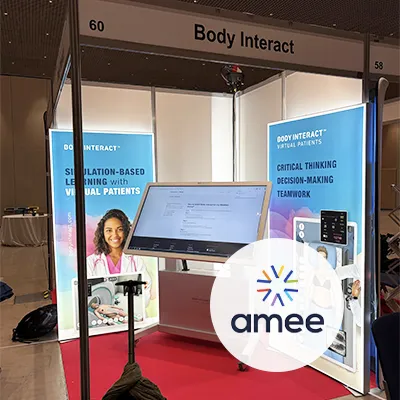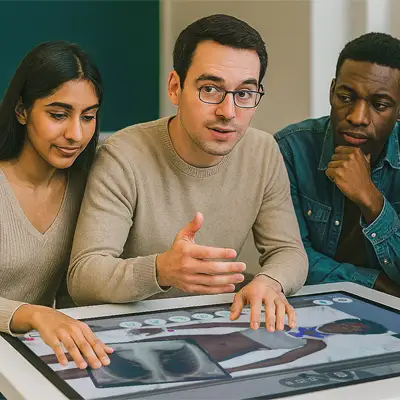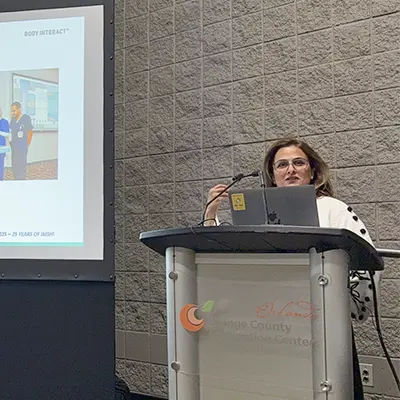More than knowing, it is important to understand. At IMSH 2020, Body Interact got the chance to present a Learning Lab experience for more than 100 participants.
A session where seven international speakers were invited to discuss their vision on how to use virtual patients in clinical education, to share their experience with Body Interact and to introduce the Virtual Patient Simulator to curious, innovative and change-making educators from around the world.
We all recognize that didactics tools are changing and virtual patients are becoming a more reliable and effective solution. Anthony LaPorta from the USA, Ichiro Kaneko from Japan, MinFang Xiang from China and Zulfiya Zaripova from Russia are four medical educators who use Body Interact and who shared, in our Learning Lab, their ideas on how learners and educators can use it for practicing, repeating and learning from mistakes.
“Students believe the system is related to their future learning”
Our first speaker, Anthony LaPorta, from Rocky Vista University, shared his experience with 42 military medical students on an “Emergency week”. Students worked on a selection of Body Interact scenarios that ranged from acute to chronic conditions and that matched the 50 types of patients they would face in their emergency training.
By combining the individual training with team-based case resolution, students were able to effectively work on their decision making and critical thinking skills.

In the morning, 98% of the students were up at 5:30 am going through the cases assigned by the teacher to start working on the clinical competencies they would explore that day. In the afternoon, the students were divided into groups of 5 or 6, and a different task (including that of being team leader) was assigned to each person, in order to solve a new clinical case as a team.
In the opinion of the surgeon professor, the major contributions of Body Interact were:
- Developing the ability to match the data collected during the resolution of the case with the final diagnosis;
- Creating an understanding of the different interactions of the many personnel involved in the care of a patient;
- Preparing students for a better transition from the classroom to real-life patient care.
[Take the chance to read Rocky Vista University most recent research on how the Virtual Patient Simulator contributes to the training of medical students]
A classroom in Japan
In Japan, problem-solving was identified in 2016 as one of the core competencies that needed to be developed in the undergraduate medical school. By using Body Interact, Prof. Kaneko, from Teikyo University Medical School, one of the speakers at our Learning Lab event, understood how virtual patients could be the educational solution used to pratice this vital skill.

Only after two lessons of a case-based discussion with Body Interact, students’ cognitive abilities were tested and their satisfaction and confidence evaluated.
The educator believes that “not only the virtual patient simulator, but a careful and safe debriefing was the key to the acquired outcome”. Also, in order, to provide with students a complete learning experience and to help them consolidate their knowledge, Prof. Kaneko takes advantage of other educational resources such as clinical guidelines, videos, pictures, schemes, etc.
Save time with Body Interact
MingFang Xiang from the First Affiliated Hospital of Shenzhen University, in China, discussed two challenges. As the person responsible for developing courses and training in Crisis Resource Management (CRM) and teamwork, he started by asking: “how can we help participants master fundamental knowledge before they take part in the course?”.

On the one hand, he realized that students prefer to learn by doing and by being instructed to read articles or other materials by the professor. On the other hand, due to the lack of the clinical scenarios available and the shortage of time for him to prepare the existing scenarios, it was very hard and almost impossible to work on a balanced solution.
For this reason, Dr Xiang has introduced Body Interact into his lessons. While he is saving time due to the Virtual Patient Simulator pre-configured scenarios, at the same time, he is now able to extend the classroom to the outside by assigning specific cases so his students can work on their clinical reasoning and decision-making skills.
Continuous learning with Virtual Patient
Zulfiya Zaripova as the head of the curriculum department of Pavlov First Saint Petersburg State Medical University believes it is essential to keep updating the national simulation system. “With such good education tools available, it is a challenge and a problem not knowing how to use it”, she concludes.

By working with Body Interact clinical scenarios the medical educator has discovered how useful it could be for undergraduate students and residents. The competencies they are exposed to in the clinical scenarios are very similar to the ones they find in their rotations.
In addition, for highly experienced professionals, it also becomes relevant for their continuous learning as it allows them to discuss the different possible approaches.


Right now, the question that Pavlov First Saint Petersburg State Medical University is addressing is where to put Body Interact. They have moved the table to their simulation centre corridor so it can be used by the curious learners and educators alike.
Don’t close the door to knowledge
From these four amazing educators we took these very different but essential Take-Home Messages:
- Dr LaPorta believes that educators need to increase the number of patients that students see in their learning process;
- Dr Ichiro Kaneko recognizes that the combination of virtual patient simulation with debriefing is a strategy that should be contemplated within education based on conventional simulations;
- Dr Zulfiya invited all educators and healthcare professionals in the room to think that “really education never stops”. After all, the students of today are the healthcare professionals of tomorrow and with the fast evolution of things it is essential to instil in them the importance of being constantly kept up to date;
- Dr MinFang Xiang mentioned that “practice makes perfect”, not only for learners but also for educators.








